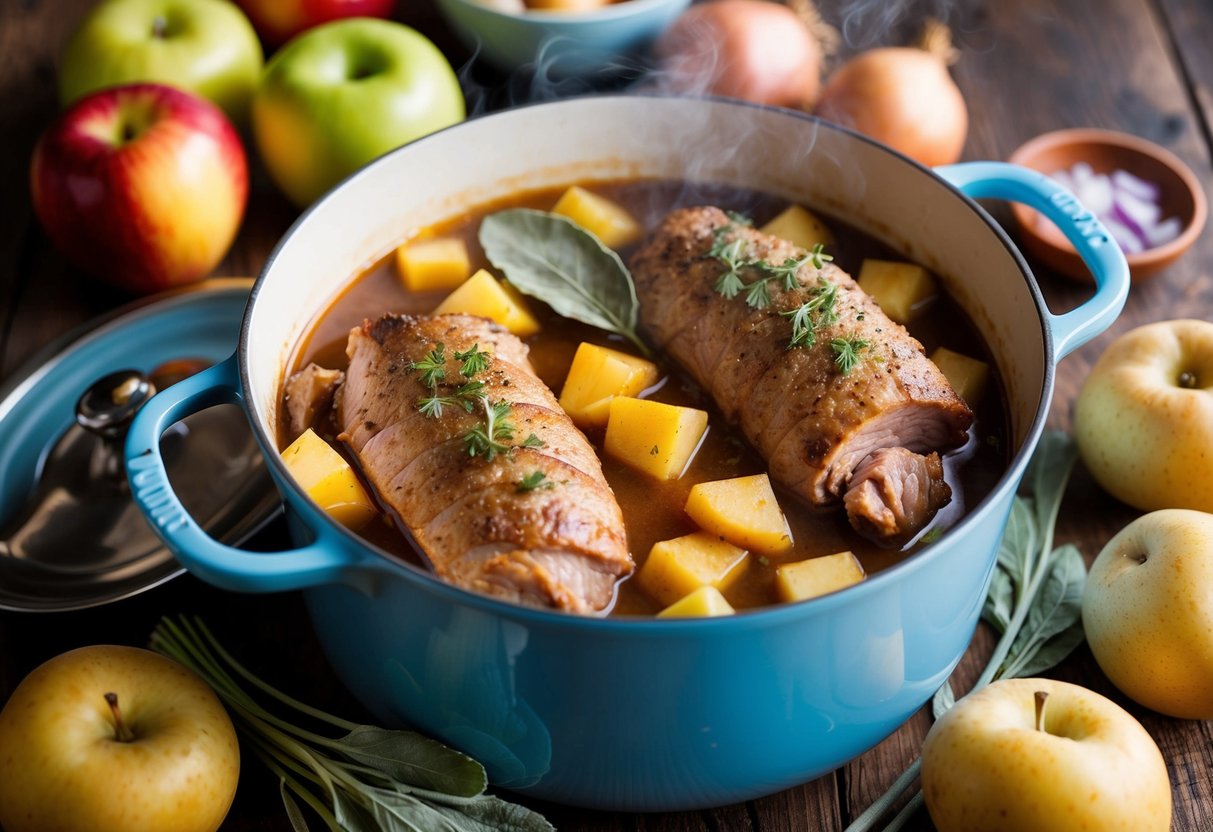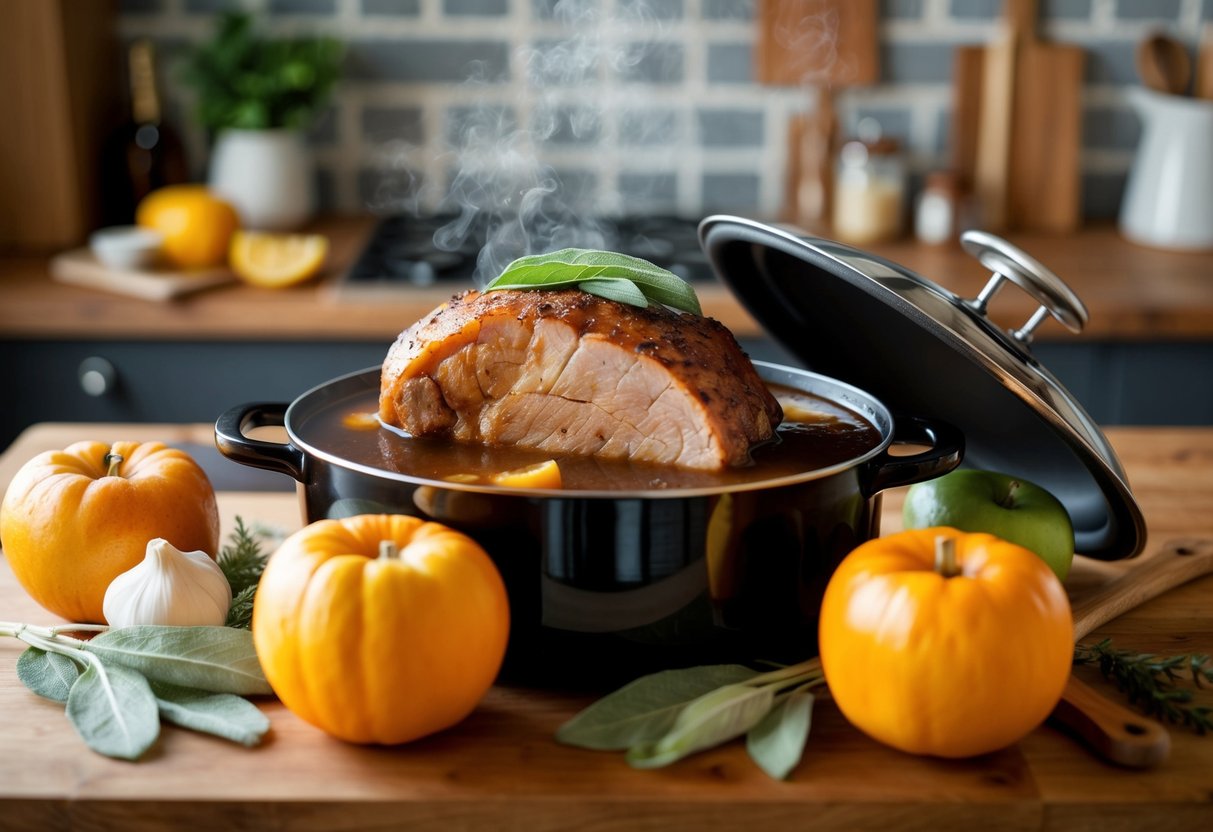This post may contain paid and/or affiliate links. I may make a small commission at no extra cost to you. Please see our Privacy Policy.
When I think of comfort food, slow-cooked dishes come to mind. One of my favourites is the slow-cooked pork, cider, and sage hotpot.
This hearty dish combines tender pork with the rich flavours of cider and aromatic sage, making it a perfect meal for colder days.
The slow cooking process allows the flavours to meld beautifully, resulting in an enticing aroma that fills the kitchen.
Jump to Recipe
I love how versatile this hotpot is; you can easily add vegetables like potatoes and carrots for extra heartiness. The combination of sweet cider with savoury pork creates a taste experience that is both satisfying and warming. It’s the kind of meal that invites everyone to gather around the table and enjoy.
Whether you’re hosting a family dinner or just looking for an easy weeknight meal, this slow-cooked pork, cider, and sage hotpot is sure to impress. With simple ingredients and straightforward steps, you’ll create a dish that feels special without much fuss.
Preparing the Ingredients

Getting the ingredients ready is crucial for making a tasty slow-cooked pork, cider, and sage hotpot. I will focus on selecting the right pork cut, preparing herbs and vegetables, and creating a flavour base that enhances the dish.
Choosing the Right Pork Cut
When selecting pork for my hotpot, I prefer using diced pork shoulder. This cut has enough fat to keep the meat tender during slow cooking. The fat renders down and adds flavour to the dish.
I look for meat that is pink with minimal browning. The marbling of fat is important. It ensures juicy meat after hours of cooking. If I can’t find shoulder, pork butt is also a good option. Both cuts are perfect for this recipe.
Herb and Vegetable Preparation
For herbs, I use fresh sage and parsley. Fresh herbs add brightness to the hotpot. I chop the sage finely, leaving a few whole leaves for garnishing later. Parsley is also chopped small.
Leeks are my go-to for this dish. I slice them thickly after trimming the root and the dark green parts. I also crush several garlic cloves, as their strong flavour is essential for the broth. I cook the leeks and garlic together to enhance their sweetness.
Creating the Flavour Base
To create a robust flavour base, I heat olive oil and butter in a large pot. The combination of these fats adds depth to the dish. I start by searing the diced pork shoulder until it is golden brown.
Then, I remove the pork and sauté the leeks and garlic until soft. Adding a tablespoon of flour to the mixture helps to thicken the sauce later. I also include bay leaves, which contribute an aromatic touch. Finally, I deglaze the pot with dry cider and stir to combine all the flavours.
Assembling and Cooking the Hotpot

In this section, I will describe how to layer the hotpot ingredients and the steps to achieve perfect slow-cooking. Both processes are essential to ensure a tasty and satisfying dish.
Layering the Hotpot
To start layering, I select my ingredients carefully. I use king Edward potatoes and sweet potatoes, which I slice evenly with a mandoline for uniform cooking.
First, I place a layer of seared pork pieces in the bottom of my ovenproof frying pan or casserole dish. Next, I add a layer of sliced potatoes, followed by chopped sage for flavour. This can be repeated, giving me multiple layers of meat and vegetables.
I take care to pour enough stock over the layers, ensuring that each slice has moisture. For this dish, I prefer to use dry cider and chicken stock for richness. After layering, I leave some space at the top to accommodate the bubbling sauce.
Perfecting the Slow-Cooking Process
Once my hotpot is assembled, I cover it with a lid to keep moisture inside. I simmer it on the stovetop, allowing it to heat for about 1 to 1.5 hours until everything is tender.
After this initial simmering, I transfer the hotpot to the oven. I bake it at 180°C (350°F) until the potatoes are soft, and a crispy layer forms on top.
The combination of single cream added at the end enriches the sauce and adds a lovely finish. With this method, I ensure that the pork is tender and the flavours meld together beautifully, resulting in a comforting sage hotpot.
Slow-Cooked Pork, Cider & Sage Hotpot
Ingredients
- 2 lbs (900g) pork shoulder, cut into large chunks
- 2 tbsp olive oil
- Salt and pepper, to taste
- 2 onions, thinly sliced
- 2 carrots, peeled and sliced into rounds
- 2 celery stalks, chopped
- 3 garlic cloves, minced
- 1 tbsp fresh sage leaves, chopped (or 1 tsp dried sage)
- 1 tbsp fresh thyme leaves
- 2 tbsp all-purpose flour
- 2 cups (480ml) apple cider (not vinegar)
- 1 cup (240ml) chicken or vegetable stock
- 2 tbsp Dijon mustard
- 2 medium apples, peeled, cored, and sliced
- 4 medium potatoes, thinly sliced (for the topping)
- 2 tbsp melted butter (for brushing)
Instructions
1. Prepare the Pork and Vegetables
- Heat 1 tbsp olive oil in a large skillet over medium-high heat. Season the pork chunks with salt and pepper. Brown the pork on all sides, then transfer to a slow cooker.
- In the same skillet, heat the remaining olive oil. Add the onions, carrots, celery, and garlic. Cook for 5 minutes until softened and fragrant.
2. Build the Hotpot Base
- Stir the sage, thyme, and flour into the vegetable mixture, coating everything evenly.
- Gradually pour in the apple cider, scraping up any browned bits from the pan, and bring to a simmer.
- Stir in the chicken or vegetable stock and Dijon mustard. Pour this mixture over the pork in the slow cooker.
3. Add Apples and Slow Cook
- Layer the sliced apples on top of the pork mixture. Cover and cook on low for 6–8 hours, or on high for 3–4 hours, until the pork is tender and the flavors have melded.
4. Add the Potato Topping
- Preheat your oven to 375°F (190°C) if your slow cooker pot is oven-safe, or transfer the hotpot to an ovenproof dish.
- Arrange the potato slices over the top of the hotpot, slightly overlapping them in a spiral pattern. Brush the potatoes with melted butter and season with a little salt.
5. Finish in the Oven
- Bake the hotpot uncovered for 30–40 minutes, or until the potatoes are golden and crisp.
6. Serve and Enjoy
- Serve hot, garnished with fresh sage leaves if desired. Pair it with crusty bread or a light green salad for a complete meal.

Slow-Cooked Pork, Cider & Sage Hotpot
Ingredients
For the Pork and Vegetables:
- 2 lbs 900g pork shoulder, cut into large chunks
- 2 tbsp olive oil
- Salt and pepper to taste
- 2 onions thinly sliced
- 2 carrots peeled and sliced into rounds
- 2 celery stalks chopped
- 3 garlic cloves minced
- 1 tbsp fresh sage leaves chopped (or 1 tsp dried sage)
- 1 tbsp fresh thyme leaves
- 2 tbsp all-purpose flour
For the Sauce:
- 2 cups 480ml apple cider (not vinegar)
- 1 cup 240ml chicken or vegetable stock
- 2 tbsp Dijon mustard
- 2 medium apples peeled, cored, and sliced
For the Topping:
- 4 medium potatoes thinly sliced
- 2 tbsp melted butter for brushing
Instructions
- Heat one tablespoon of olive oil in a large skillet over medium-high heat. Season the pork chunks generously with salt and pepper, then sear them in the hot skillet until browned on all sides. Once browned, transfer the pork to a slow cooker. In the same skillet, add the remaining olive oil and sauté the onions, carrots, celery, and garlic for about five minutes until softened and fragrant.
- Sprinkle the sage, thyme, and flour over the vegetables, stirring until everything is evenly coated. Gradually pour in the apple cider, scraping up any browned bits from the bottom of the pan, and bring to a gentle simmer. Add the chicken or vegetable stock and Dijon mustard, stirring to combine. Pour this mixture over the pork in the slow cooker, then layer the sliced apples on top. Cover and cook on low for six to eight hours, or on high for three to four hours, until the pork is tender and the flavors are well-developed.
- Preheat your oven to 375°F (190°C). If your slow cooker pot is oven-safe, leave the hotpot in it; otherwise, transfer the contents to an ovenproof dish. Arrange the potato slices in overlapping layers on top of the hotpot in a spiral pattern. Brush the potatoes with melted butter and season lightly with salt.
- Place the hotpot in the oven and bake uncovered for 30 to 40 minutes, or until the potatoes are golden and crisp. Once ready, serve the dish hot, garnished with fresh sage leaves if desired. Pair it with crusty bread or a light green salad for a hearty and comforting meal.
Frequently Asked Questions

I will answer some common questions about preparing a slow-cooked pork, cider, and sage hotpot. This includes details about essential ingredients, cooking times, substitutions, and preparation techniques.
What are the essential ingredients for a pork hotpot?
The main ingredients for a pork hotpot include diced pork shoulder, dry cider, leeks, garlic, sage, and chicken stock. I also like to add bay leaves and a bit of flour for thickening.
How long should pork be slow-cooked in cider to ensure tenderness?
I find that cooking the pork in cider for about 1 to 1.5 hours on the stovetop works well. The pork should become tender enough to fall apart during the final cooking step.
Can sage be substituted with another herb in a pork hotpot recipe?
Yes, if I don’t have sage, I can use thyme or rosemary as alternatives. These herbs provide a different flavour but still complement the pork nicely.
Is it possible to use a different cut of pork for a cider-based hotpot?
Absolutely. I can use cuts like pork loin or tenderloin, but they may require less cooking time. I prefer shoulder for its rich flavour and tenderness.
What are the steps to prepare a creamy cider sauce for pork dishes?
To prepare a creamy cider sauce, I first cook down the cider until it reduces. Then I add cream, stirring until thickened. This sauce can be poured over the cooked pork just before serving.
How can I adapt a slow-cooked pork recipe for a beef hotpot instead?
To adapt a pork recipe for beef, I can replace the pork with diced beef chuck. The cooking time may need to be adjusted. Usually, it takes around 2 to 3 hours until the beef is tender.
